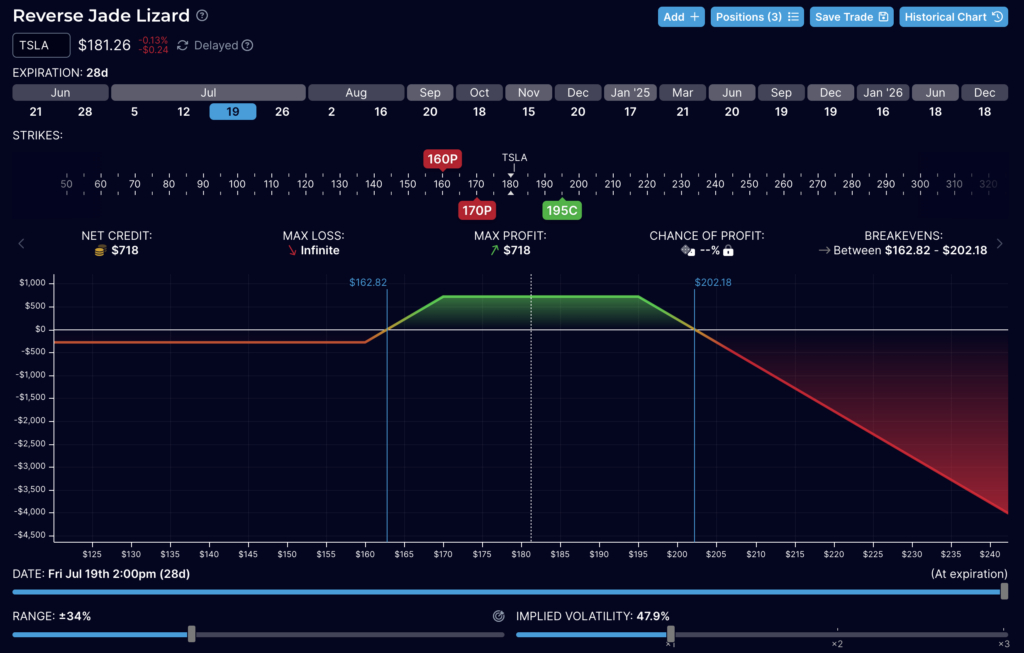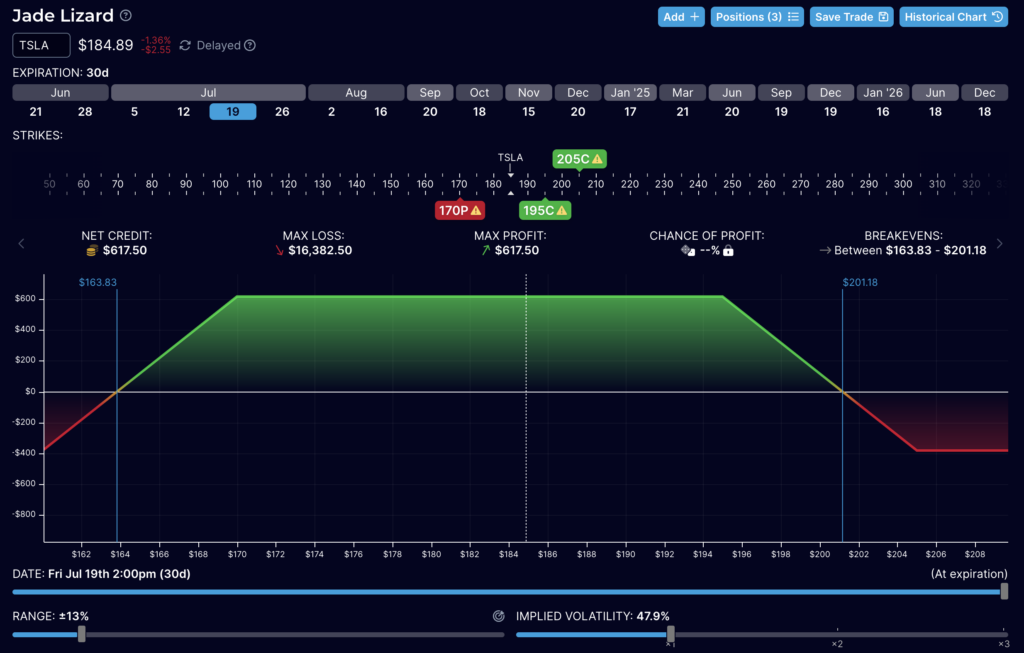There are tons of option selling strategies in the market with a hedge which are made for different market conditions for traders with different risk appetite. These option selling strategies offer a higher chance of profit with limited loss. Among these strategies are the Jade Lizard Strategy and the Reverse Jade Lizard Strategy. These two strategies stand out due to their risk-reward profiles. In this article we will dive deep into the use of these strategies and discuss how they work. This is a guide to help option sellers maximise their potential in the options trading market. If you want to use this strategy, make sure to ask your broker if option writing is enabled in your account.
Understanding the Jade Lizard Strategy
The Jade Lizard strategy is made for option writers who want a low-risk strategy with high winning probability made for sideways to bullish market conditions. It is made by combining the elements of credit spreads and naked options to create a position which has a limited risk of loss and a potential for unlimited profit.
Components of the Jade Lizard Strategy
The Jade Lizard strategy is made out of two components.
- Selling an Out-of-the-Money (OTM Strike Price) Call Spread: This involves selling an Out of the money strike price call option and buying a further OTM Strike Price call to create a vertical call spread. For example you sold Asset 1 Call Option Strike price 100 (assuming current price is 80) and you bought a call option with a strike price of 120.
- Selling an Out-of-the-Money (OTM Strike Price) Put: This is done to collect an additional premium and increase the overall credit that is received.
How It Works
This strategy works by combining the two components above. By combining these, the loss on the upper side gets limited and there is a higher chance of profit. The maximum loss is limited to the difference between the two strike prices of the call spread minus the premium received. The profit is limited to the total premium collected from selling the call spread and the put option.
Example:
- Sell 1 OTM Call at $100
- Buy 1 OTM Call at $110
- Sell 1 OTM Put at $90
The trader is able to collect premiums from the call spread and the put option .
Benefits
We cannot finish this strategy without talking about the huge benefits of it compared to other strategies.
- Limited Risk: The maximum loss is limited and occurs only when there is a huge movement in the market.
- High Probability of Success: Most of the time we already know how much the market will move. If the market makes a small movement upside or downside or remains sideways, we make a profit in all these conditions. However if there is a huge movement in the upside or downside, there is a risk of loss.
- Flexibility: It is suitable for various market conditions that is slight bullish, sideways and slight bearish market.
Exploring the Reverse Jade Lizard Strategy
The Reverse Jade Lizard is a variation of the Jade Lizard strategy. This is designed for a different market condition. This strategy is used if there is a limited downside movement.
Components of the Reverse Jade Lizard Strategy
- Selling an Out-of-the-Money (OTM Strike Price) Put Spread: This involves selling an Out of the money strike price put option and buying a further OTM Strike Price put option to create a vertical put spread. For example you sold Asset 1 Put Option Strike price 60 (assuming current price is 80) and you bought a put option with a strike price of 50.
- Selling an Out-of-the-Money (OTM) Call: This is done to collect additional premium and increase the overall credit that is received.

How It Works
The Reverse Jade Lizard strategy creates a position where the maximum loss is limited to the difference between the strike prices of the put spread minus the premium received. The maximum profit is the total premium collected from selling the put spread and the call.
Example:
- Sell 1 OTM Put at $45
- Buy 1 OTM Put at $40
- Sell 1 OTM Call at $50
In this setup, the trader collects premiums from the put spread and the call option. The goal is for the underlying asset to remain above the lower put strike price but below the call strike price by expiration, allowing the trader to keep the entire premium collected.
Benefits
- Defined Risk: The maximum loss is limited. The loss only occurs if there is a huge movement in the market.
- High Probability of Success: This strategy combines credit spread and naked call which gives a huge probability of profit.
- Versatility: This strategy is flexible and is good when the market is sideways to slightly bearish.
Key Considerations
Although both the strategies (Jade Lizard and Reverse Jade Lizard) offer a high probability of profit and limited risk potential, traders still need to keep a few points in mind when using this strategy.
- Market Conditions: Always check the market condition and make analysis. Wrong analysis, could put you in a huge risk of loss.
- Strike Prices: Select the strike prices which align with the current market conditions and that also meets your risk tolerance.
- Expiration Dates: Always choose expiry dates that provide you enough time and also a good profit so that if the market moves against your analysis, you can always make adjustments to still make a profit.
Conclusion
Both the strategies are great if they are used correctly in the right market conditions. These two strategies offer a high chance of success and a limited risk of loss. By understanding market conditions and correctly implementing the two strategies, a conservative trader can make good and stable returns in the market. These strategies can help you achieve you financial goals with confidence.
For more advanced options trading insights and strategies, subscribe to our blog and enhance your trading expertise with our comprehensive guides and tutorials.
If you are in India, Sensibull supports Jade Lizard and Reverse Jade Lizard Strategy.
If you are in the US or Canada, you may try OptionStrat
Filing Taxes? Try our GST Calculator.
